Essay: HLSC120 Indigenous Health and Culture at University
VerifiedAdded on 2021/04/16
|6
|1232
|41
Essay
AI Summary
This essay, written for HLSC120: Indigenous Health and Culture, explores the health and cultural practices of Aboriginal and Torres Strait Islander peoples. It begins with personal observations of rituals and cultural practices, emphasizing the importance of family and community in shaping individual identity and well-being. The essay then discusses the shared cultural traits, economic dealings, and customary systems of these indigenous groups, highlighting their concept of 'punya' and its connection to well-being. The author reflects on how their initial perceptions were challenged by close interactions with these communities. Furthermore, the essay examines the influence of mainstream media, often portraying indigenous peoples in a negative light, and the impact of historical factors like colonization on their mental and physical health. The conclusion emphasizes the resilience of indigenous communities in maintaining their cultural connections and striving for self-determination, recognizing the significance of family networks and community support in health outcomes. References to relevant literature are included to support the analysis.

Running head: HLSC120: INDIGENOUS HEALTH AND CULTURE
HLSC120: INDIGENOUS HEALTH AND CULTURE
Name of the Student:
Name of the University:
Author Note:
HLSC120: INDIGENOUS HEALTH AND CULTURE
Name of the Student:
Name of the University:
Author Note:
Paraphrase This Document
Need a fresh take? Get an instant paraphrase of this document with our AI Paraphraser
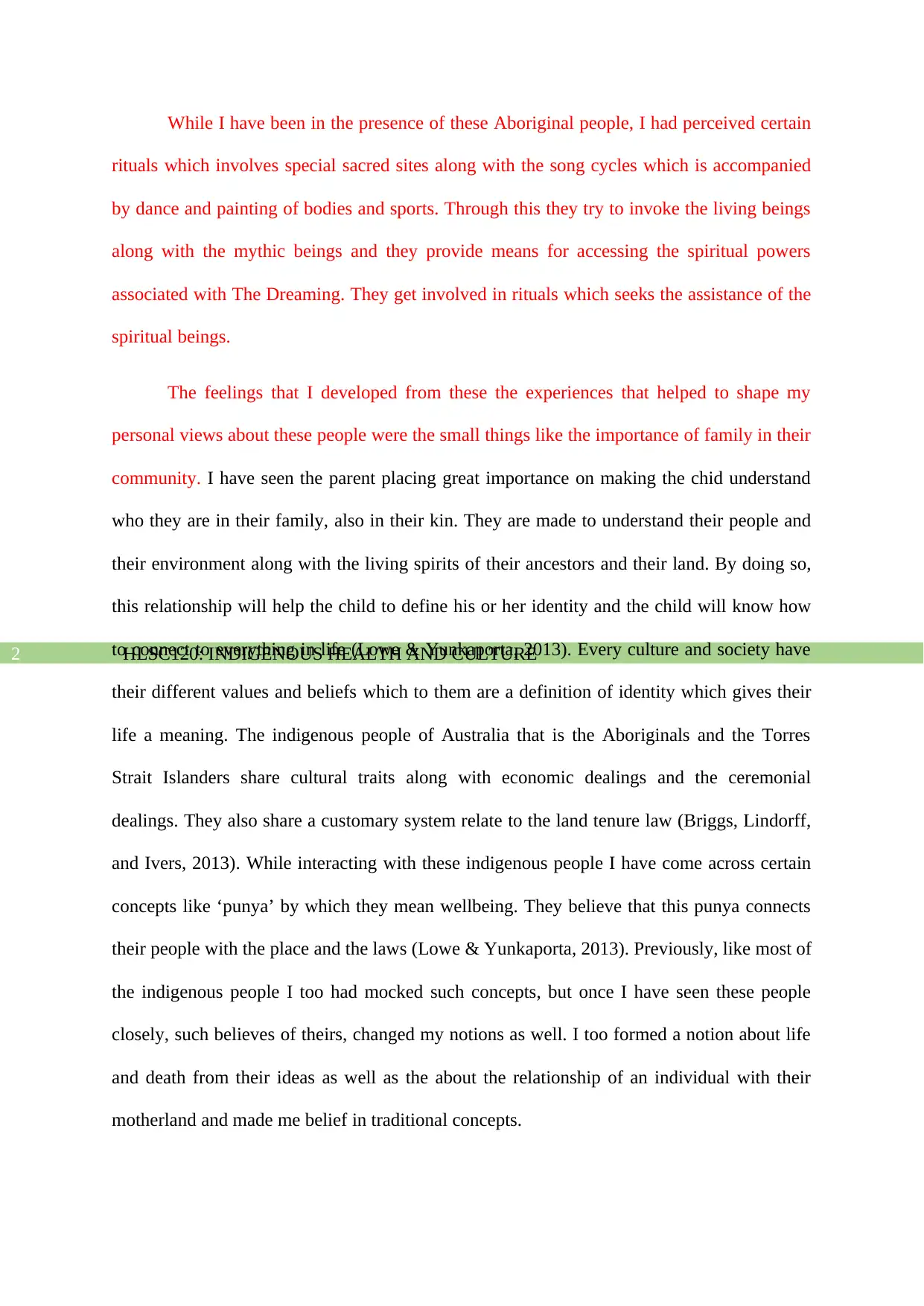
HLSC120: INDIGENOUS HEALTH AND CULTURE2
While I have been in the presence of these Aboriginal people, I had perceived certain
rituals which involves special sacred sites along with the song cycles which is accompanied
by dance and painting of bodies and sports. Through this they try to invoke the living beings
along with the mythic beings and they provide means for accessing the spiritual powers
associated with The Dreaming. They get involved in rituals which seeks the assistance of the
spiritual beings.
The feelings that I developed from these the experiences that helped to shape my
personal views about these people were the small things like the importance of family in their
community. I have seen the parent placing great importance on making the chid understand
who they are in their family, also in their kin. They are made to understand their people and
their environment along with the living spirits of their ancestors and their land. By doing so,
this relationship will help the child to define his or her identity and the child will know how
to connect to everything in life (Lowe & Yunkaporta, 2013). Every culture and society have
their different values and beliefs which to them are a definition of identity which gives their
life a meaning. The indigenous people of Australia that is the Aboriginals and the Torres
Strait Islanders share cultural traits along with economic dealings and the ceremonial
dealings. They also share a customary system relate to the land tenure law (Briggs, Lindorff,
and Ivers, 2013). While interacting with these indigenous people I have come across certain
concepts like ‘punya’ by which they mean wellbeing. They believe that this punya connects
their people with the place and the laws (Lowe & Yunkaporta, 2013). Previously, like most of
the indigenous people I too had mocked such concepts, but once I have seen these people
closely, such believes of theirs, changed my notions as well. I too formed a notion about life
and death from their ideas as well as the about the relationship of an individual with their
motherland and made me belief in traditional concepts.
While I have been in the presence of these Aboriginal people, I had perceived certain
rituals which involves special sacred sites along with the song cycles which is accompanied
by dance and painting of bodies and sports. Through this they try to invoke the living beings
along with the mythic beings and they provide means for accessing the spiritual powers
associated with The Dreaming. They get involved in rituals which seeks the assistance of the
spiritual beings.
The feelings that I developed from these the experiences that helped to shape my
personal views about these people were the small things like the importance of family in their
community. I have seen the parent placing great importance on making the chid understand
who they are in their family, also in their kin. They are made to understand their people and
their environment along with the living spirits of their ancestors and their land. By doing so,
this relationship will help the child to define his or her identity and the child will know how
to connect to everything in life (Lowe & Yunkaporta, 2013). Every culture and society have
their different values and beliefs which to them are a definition of identity which gives their
life a meaning. The indigenous people of Australia that is the Aboriginals and the Torres
Strait Islanders share cultural traits along with economic dealings and the ceremonial
dealings. They also share a customary system relate to the land tenure law (Briggs, Lindorff,
and Ivers, 2013). While interacting with these indigenous people I have come across certain
concepts like ‘punya’ by which they mean wellbeing. They believe that this punya connects
their people with the place and the laws (Lowe & Yunkaporta, 2013). Previously, like most of
the indigenous people I too had mocked such concepts, but once I have seen these people
closely, such believes of theirs, changed my notions as well. I too formed a notion about life
and death from their ideas as well as the about the relationship of an individual with their
motherland and made me belief in traditional concepts.
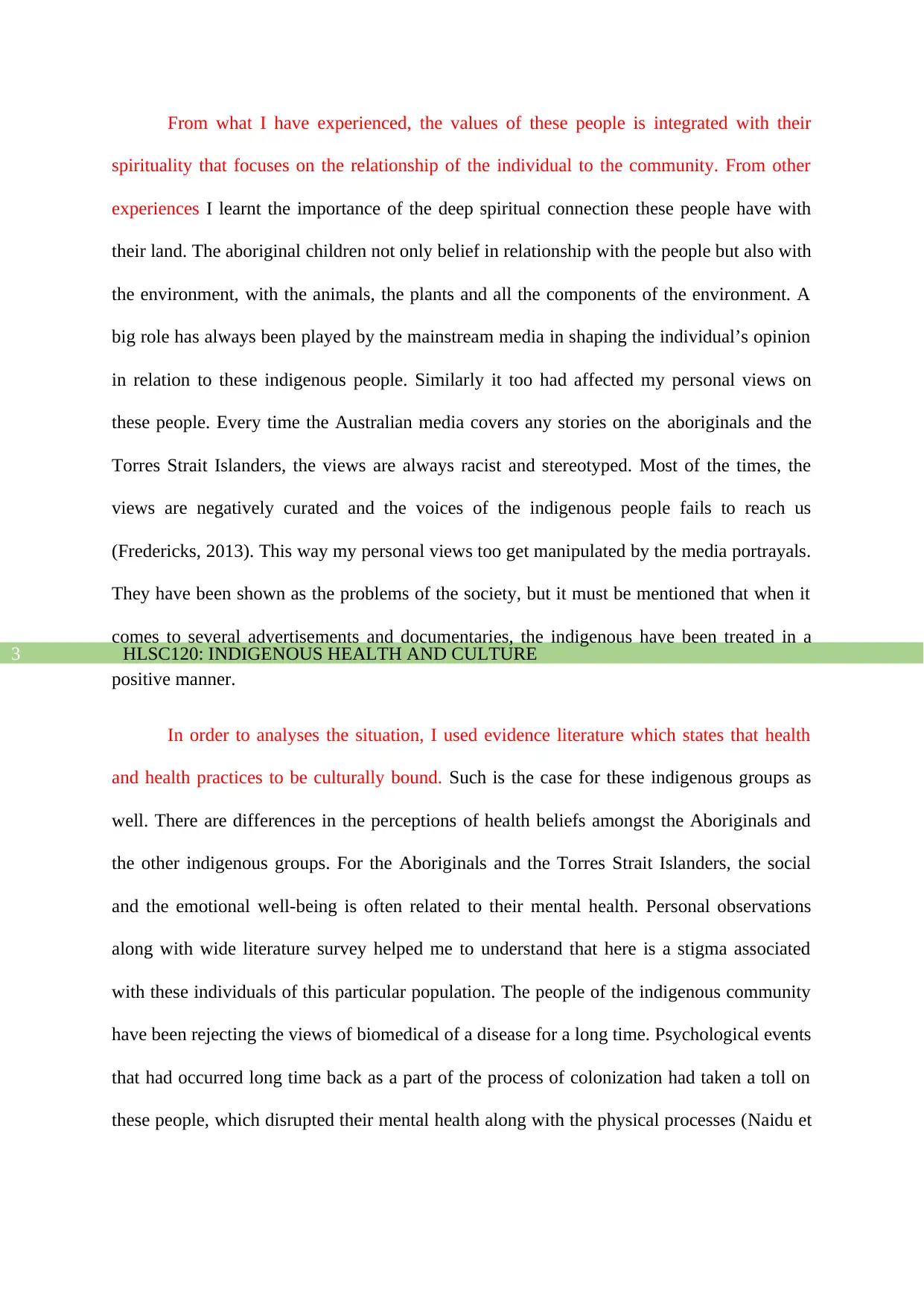
HLSC120: INDIGENOUS HEALTH AND CULTURE3
From what I have experienced, the values of these people is integrated with their
spirituality that focuses on the relationship of the individual to the community. From other
experiences I learnt the importance of the deep spiritual connection these people have with
their land. The aboriginal children not only belief in relationship with the people but also with
the environment, with the animals, the plants and all the components of the environment. A
big role has always been played by the mainstream media in shaping the individual’s opinion
in relation to these indigenous people. Similarly it too had affected my personal views on
these people. Every time the Australian media covers any stories on the aboriginals and the
Torres Strait Islanders, the views are always racist and stereotyped. Most of the times, the
views are negatively curated and the voices of the indigenous people fails to reach us
(Fredericks, 2013). This way my personal views too get manipulated by the media portrayals.
They have been shown as the problems of the society, but it must be mentioned that when it
comes to several advertisements and documentaries, the indigenous have been treated in a
positive manner.
In order to analyses the situation, I used evidence literature which states that health
and health practices to be culturally bound. Such is the case for these indigenous groups as
well. There are differences in the perceptions of health beliefs amongst the Aboriginals and
the other indigenous groups. For the Aboriginals and the Torres Strait Islanders, the social
and the emotional well-being is often related to their mental health. Personal observations
along with wide literature survey helped me to understand that here is a stigma associated
with these individuals of this particular population. The people of the indigenous community
have been rejecting the views of biomedical of a disease for a long time. Psychological events
that had occurred long time back as a part of the process of colonization had taken a toll on
these people, which disrupted their mental health along with the physical processes (Naidu et
From what I have experienced, the values of these people is integrated with their
spirituality that focuses on the relationship of the individual to the community. From other
experiences I learnt the importance of the deep spiritual connection these people have with
their land. The aboriginal children not only belief in relationship with the people but also with
the environment, with the animals, the plants and all the components of the environment. A
big role has always been played by the mainstream media in shaping the individual’s opinion
in relation to these indigenous people. Similarly it too had affected my personal views on
these people. Every time the Australian media covers any stories on the aboriginals and the
Torres Strait Islanders, the views are always racist and stereotyped. Most of the times, the
views are negatively curated and the voices of the indigenous people fails to reach us
(Fredericks, 2013). This way my personal views too get manipulated by the media portrayals.
They have been shown as the problems of the society, but it must be mentioned that when it
comes to several advertisements and documentaries, the indigenous have been treated in a
positive manner.
In order to analyses the situation, I used evidence literature which states that health
and health practices to be culturally bound. Such is the case for these indigenous groups as
well. There are differences in the perceptions of health beliefs amongst the Aboriginals and
the other indigenous groups. For the Aboriginals and the Torres Strait Islanders, the social
and the emotional well-being is often related to their mental health. Personal observations
along with wide literature survey helped me to understand that here is a stigma associated
with these individuals of this particular population. The people of the indigenous community
have been rejecting the views of biomedical of a disease for a long time. Psychological events
that had occurred long time back as a part of the process of colonization had taken a toll on
these people, which disrupted their mental health along with the physical processes (Naidu et
⊘ This is a preview!⊘
Do you want full access?
Subscribe today to unlock all pages.

Trusted by 1+ million students worldwide
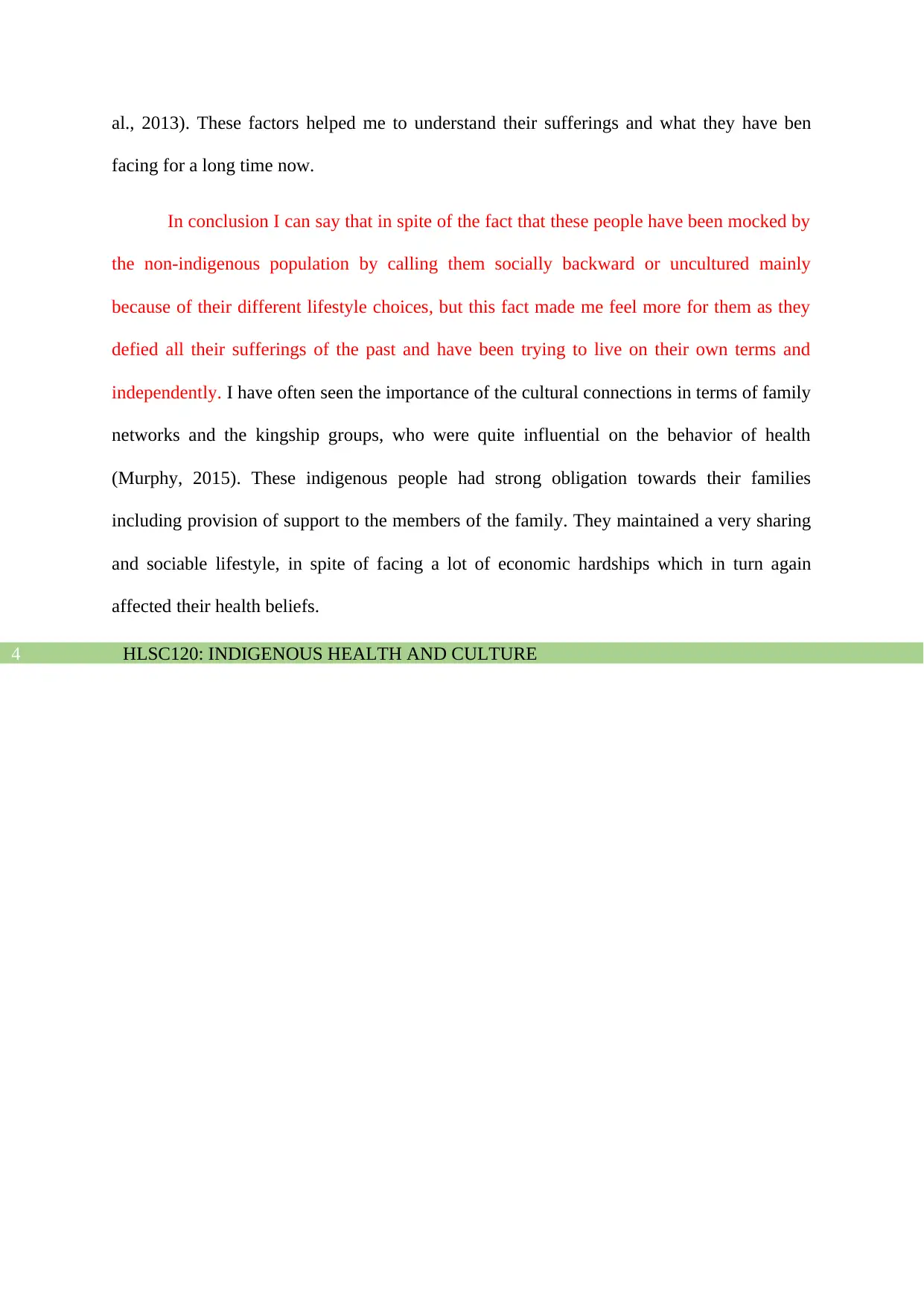
HLSC120: INDIGENOUS HEALTH AND CULTURE4
al., 2013). These factors helped me to understand their sufferings and what they have ben
facing for a long time now.
In conclusion I can say that in spite of the fact that these people have been mocked by
the non-indigenous population by calling them socially backward or uncultured mainly
because of their different lifestyle choices, but this fact made me feel more for them as they
defied all their sufferings of the past and have been trying to live on their own terms and
independently. I have often seen the importance of the cultural connections in terms of family
networks and the kingship groups, who were quite influential on the behavior of health
(Murphy, 2015). These indigenous people had strong obligation towards their families
including provision of support to the members of the family. They maintained a very sharing
and sociable lifestyle, in spite of facing a lot of economic hardships which in turn again
affected their health beliefs.
al., 2013). These factors helped me to understand their sufferings and what they have ben
facing for a long time now.
In conclusion I can say that in spite of the fact that these people have been mocked by
the non-indigenous population by calling them socially backward or uncultured mainly
because of their different lifestyle choices, but this fact made me feel more for them as they
defied all their sufferings of the past and have been trying to live on their own terms and
independently. I have often seen the importance of the cultural connections in terms of family
networks and the kingship groups, who were quite influential on the behavior of health
(Murphy, 2015). These indigenous people had strong obligation towards their families
including provision of support to the members of the family. They maintained a very sharing
and sociable lifestyle, in spite of facing a lot of economic hardships which in turn again
affected their health beliefs.
Paraphrase This Document
Need a fresh take? Get an instant paraphrase of this document with our AI Paraphraser
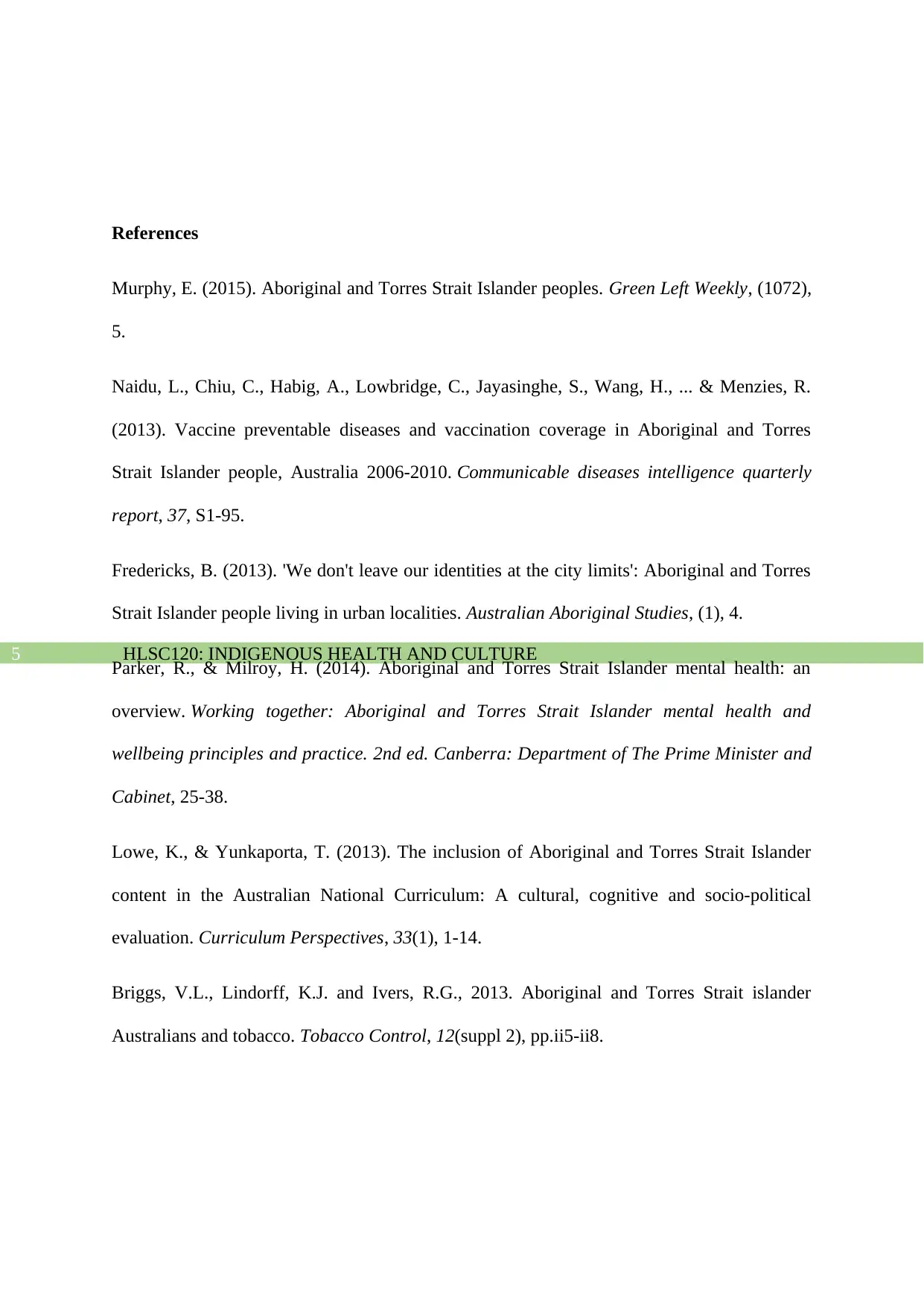
HLSC120: INDIGENOUS HEALTH AND CULTURE5
References
Murphy, E. (2015). Aboriginal and Torres Strait Islander peoples. Green Left Weekly, (1072),
5.
Naidu, L., Chiu, C., Habig, A., Lowbridge, C., Jayasinghe, S., Wang, H., ... & Menzies, R.
(2013). Vaccine preventable diseases and vaccination coverage in Aboriginal and Torres
Strait Islander people, Australia 2006-2010. Communicable diseases intelligence quarterly
report, 37, S1-95.
Fredericks, B. (2013). 'We don't leave our identities at the city limits': Aboriginal and Torres
Strait Islander people living in urban localities. Australian Aboriginal Studies, (1), 4.
Parker, R., & Milroy, H. (2014). Aboriginal and Torres Strait Islander mental health: an
overview. Working together: Aboriginal and Torres Strait Islander mental health and
wellbeing principles and practice. 2nd ed. Canberra: Department of The Prime Minister and
Cabinet, 25-38.
Lowe, K., & Yunkaporta, T. (2013). The inclusion of Aboriginal and Torres Strait Islander
content in the Australian National Curriculum: A cultural, cognitive and socio-political
evaluation. Curriculum Perspectives, 33(1), 1-14.
Briggs, V.L., Lindorff, K.J. and Ivers, R.G., 2013. Aboriginal and Torres Strait islander
Australians and tobacco. Tobacco Control, 12(suppl 2), pp.ii5-ii8.
References
Murphy, E. (2015). Aboriginal and Torres Strait Islander peoples. Green Left Weekly, (1072),
5.
Naidu, L., Chiu, C., Habig, A., Lowbridge, C., Jayasinghe, S., Wang, H., ... & Menzies, R.
(2013). Vaccine preventable diseases and vaccination coverage in Aboriginal and Torres
Strait Islander people, Australia 2006-2010. Communicable diseases intelligence quarterly
report, 37, S1-95.
Fredericks, B. (2013). 'We don't leave our identities at the city limits': Aboriginal and Torres
Strait Islander people living in urban localities. Australian Aboriginal Studies, (1), 4.
Parker, R., & Milroy, H. (2014). Aboriginal and Torres Strait Islander mental health: an
overview. Working together: Aboriginal and Torres Strait Islander mental health and
wellbeing principles and practice. 2nd ed. Canberra: Department of The Prime Minister and
Cabinet, 25-38.
Lowe, K., & Yunkaporta, T. (2013). The inclusion of Aboriginal and Torres Strait Islander
content in the Australian National Curriculum: A cultural, cognitive and socio-political
evaluation. Curriculum Perspectives, 33(1), 1-14.
Briggs, V.L., Lindorff, K.J. and Ivers, R.G., 2013. Aboriginal and Torres Strait islander
Australians and tobacco. Tobacco Control, 12(suppl 2), pp.ii5-ii8.
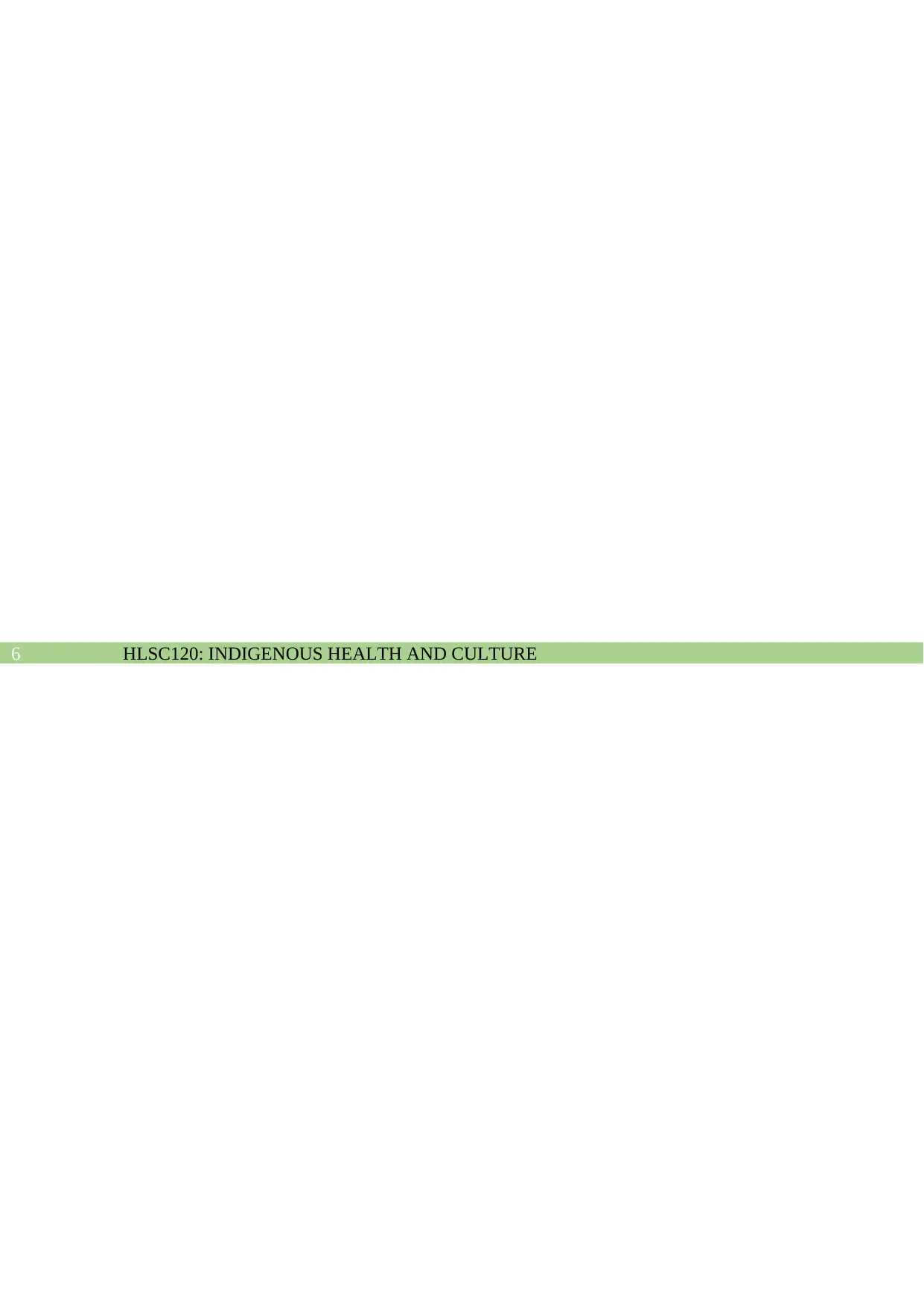
HLSC120: INDIGENOUS HEALTH AND CULTURE6
⊘ This is a preview!⊘
Do you want full access?
Subscribe today to unlock all pages.

Trusted by 1+ million students worldwide
1 out of 6
Related Documents
Your All-in-One AI-Powered Toolkit for Academic Success.
+13062052269
info@desklib.com
Available 24*7 on WhatsApp / Email
![[object Object]](/_next/static/media/star-bottom.7253800d.svg)
Unlock your academic potential
Copyright © 2020–2025 A2Z Services. All Rights Reserved. Developed and managed by ZUCOL.




